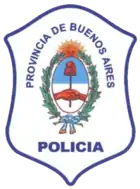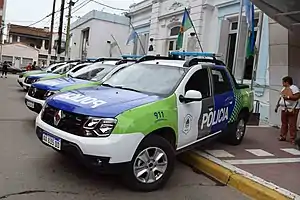Buenos Aires Provincial Police
The Buenos Aires Provincial Police (Spanish: Policía de la Provincia de Buenos Aires, informally Policía Bonaerense) is the police service responsible for policing the Province of Buenos Aires, in Argentina.
| Policía de la Provincia de Buenos Aires | |
|---|---|
 | |
| Agency overview | |
| Formed | 1880 [1] |
| Employees | +90,000 |
| Jurisdictional structure | |
| General nature | |
| Operational structure | |
| Elected officer responsible |
|
| Agency executive |
|
| Website | |
| Police at Ministry of Justice website | |
It is one of the biggest police services of Argentina, responsible for policing a province of over 15 million inhabitants, about 38% of Argentina's entire population. The Federal Capital district of Buenos Aires city is under the separate jurisdiction of the Buenos Aires City Police.
The institution is usually referred to as Policía Bonaerense, where bonaerense is the demonym for the Province of Buenos Aires. This contrasts with porteño, used for the inhabitants of the Buenos Aires city.
This police force is subordinate to the Provincial Ministry of Security headed by Minister Sergio Berni.[2] The Chief of the force is Daniel Alberto García, after Fabian Perroni quit the police force in November 2019.[3]
Police Ranks

Until January 2005, the Buenos Aires Police used the same rank system as employed by the Federal Police and other Argentine provincial police forces. This system consisted of seventeen ranks, of which nine were for (commissioned) officers and eight were for sub-officers (including the basic rank of agent). A new and simplified rank system was established through passage of a law governing police personnel.
This system officially abolished the distinction between (commissioned) officers and sub-officers. It instituted a rank system consisting of the following nine ranks, listed in descending order:
| Rank | English translation |
|---|---|
| Superintendente | Superintendent |
| Comisionado | Commissioner |
| Inspector | Inspector |
| Capitán | Captain |
| Teniente Primero | First Lieutenant |
| Teniente | Lieutenant |
| Subteniente | Sublieutenant |
| Sargento | Sergeant |
| Oficial de Policía | Police Officer |
Current rank system
As of 2009, a new law modified the police ranks and established some variations (Ley 13.982/09).[4] It establishes different personnel rankings ("Escalafones" as they are called in Spanish), which relate to operational responsibilities:
- Officers of the General ranking;
- Officers of the Command ranking;
- Professional Officers;
- Administrative Officers;
- Technical Officers;
- General Services personnel;
- 911 personnel;
- Civilian personnel.
| Current rank system | |
|---|---|
| Command | |
| Rank | Insignias |
| Comisario General | |
| Comisario Mayor | |
| Comisario Inspector | |
| Comisario | |
| Subcomisario | |
| Oficial Principal | |
| Oficial Inspector | |
| Oficial Subinspector | |
| Oficial Ayudante | |
| Oficial Subayudante | |
| General | |
| Mayor | |
| Capitán | |
| Teniente 1º | |
| Teniente | |
| Subteniente | |
| Sargento | |
| Oficial | |
The current levels for the Command sub-ranking are (ten levels) in descending order:
- 1) Conducting Officers:
Comisario General
Comisario Mayor
- 2) Supervision Officers:
Comisario Inspector
- 3) Chief Officers:
Comisario
Subcomisario
- 4) Subordinate Officers:
Oficial Principal
Oficial Inspector
Oficial Subinspector
Oficial Ayudante
Oficial Subayudante
The General sub-ranking defines seven levels (the general sub-ranking is subordinate to the commando sub-ranking, so its highest ranking is subordinate to the lowest ranking of commando officers):
- 1) Superior Officers:
Mayor (Major)
Capitán (Captain)
Teniente 1ro. (First Lieutenant)
- 2) Subordinate Officers:
Teniente (Lieutenant)
Subteniente (Sublieutenant)
Sargento (Sergeant)
Oficial (Officer)
- 3) Police Academy cadet.
Both the Commando and General rankings represent the sworn officers (armed personnel). The other rankings constitute the support staff. For the Professional, Technical and Administrative sub-rankings, the levels of the Commando sub-ranking is employed. The subordinate relationship between the subrankings makes the Commando ranking the highest group over all.
Equipment
Arms
- Bersa Thunder 9[5]
- Ithaca 37
- Hatsan Escort AimGuard
- Mossberg 500
- FMK-3[6]
- IMI Uzi
- FN FAL
- Remington 700
Vehicles
Helicópters
See also
References
- "Celebración del 132 aniversario de la creación de la Policía Bonaerense" at Rivadavia Online Archived December 15, 2013, at the Wayback Machine
- Sergio Berni, Gerardo Morales test positive for coronavirus, BA Times, 14-08-2020
- Ley 13982 on Government of Buenos Aires Province website
- "Magnum - Armas utilizados por la policía bonaerense - 19". Archived from the original on 26 April 2017. Retrieved 25 April 2017.
- Magnum - Armas utilizados por la policía bonaerense - 16
- Vidal maquilla a la fuerza con verde flúo
- Ritondo entregó nuevos patrulleros a la Policía Bonaerense
- SWAT Bonaerense: las nuevas Ram blindadas del Grupo Halcón
- "Dirección General de Servicios y Operaciones Aéreas". Archived from the original on 12 May 2017. Retrieved 18 Oct 2017.
External links
 Media related to Buenos Aires Provincial Police at Wikimedia Commons
Media related to Buenos Aires Provincial Police at Wikimedia Commons- Police website
- Ministry of Security website